| WATER | |
| | |
| A classical element. The famous words 'Panta rhei' (='Everything flows') are assigned to Heraclitus. Though it isn't recorded nor proved he said exactly this, but his philosophy based on the continuous change of things, he explained the Universe as an ever-changing, renewing stream. He was only partially true1. Earlier I mentioned the concept of 'archai'2. Thales thought water is the archai, the principle of all matter. Today we know that it is 'just' two hydrogen atoms and an oxygen atom glued together by covalent bonds (shared electron pairs). H2O. It is understandable that water seemed a fantastic material3 to the people of ancient cultures: a material which flows, changes it shape. And yes, water is a fantastic substance. It has a lot of crazy properties (relatively high melting and boiling point, high enthalpy of evaporation, high surface tension, capillary action etc.), all of them can be explained by its relatively strong hydrogen bonds. You could make a 2 hours long lecture about water and still have enough interesting material to make 10+ more lectures about it.
Look around! Water is everywhere! Rivers, lakes, seas, rain, snow, clouds, ice... our body is a big, gelly blob, containing at least 55% water (depending on body size and age). It is basically colorless, but a blue tint gets visible as the amount gets greater4. Pure water also doesn't have a taste. Tap water's pleasant taste is caused by Ca(HCO3)2 and Mg(HCO3)2, which are chemically extracted by the slightly carbonated rainwater from limestone mountains. The fact that all 3 states of matter of water is present on our planet can be explained that Earth's average temperature is very close to water's triple point5. It is also worth noting, that pure water contains more than just simple H2O-molecules. Firstly, water molecules are capable of doing an almost black magic like thingie: to give a proton to another water molecule. This creates H3O+ and OH- ions in the water making it very slightly electrically conductive. Secondly, hydrogen has 3 isotopes (protium [1H] 1 p+ in the nucleus, deuterium [D, 2H] 1p+ and 1 n0, tritium [T, 3H] - 1 p+ and 2 n0), and oxygen, too (16O, 17O, 18O)6. This results in 9 different water molecules, "normal" water (1H216O) being only one of them - but this makes up more than 99% of water. Probably you heard about heavy water, which is D2O, or semiheavy water, which is HDO. Oddly enough heavy water can be lethal to biological systems at concentrations over 50%, because it affects enzymes, hydrogen bonds and cell division. Heavy water has its industrial usage, for example it can act as a neutron moderator in nuclear reactors.
About 71% of Earth is covered by water. But only 2.5% of our water is freshwater to drink. 10 billion tons of freshwater is used daily. The biggest user is agriculture: more than 70% of this water is used by them. The Virtual Water usage by an average person is about 4000-5000 liter. But what is Virtual Water? Every item needs a certain amount of water to produce. There is a 20 liter water consumption in the making of a single sheet of paper (A4). You need about 15,000 liter water to produce 1 kg beef! (It is worth looking up similar data, you'll be surprised!) These numbers add up to form your personal Virtual Water need - depending on your daily consumption. (A side note: fruits and vegetables need MUCH less water for their production than different types of meats.)
It is almost incomprehensible how many uses water has! Drinking, washing, using for heat exchange (steam, water), producing electricity (hydroelectricity), solvent, fire extinguishing, food processing (boiling, steaming, simmering), recreation... people even lick coloured and flavoured ice for fun...  The first mirror ever used!7 Not just prevalent, but omnipresent and VITAL for life... no wonder even religions incorporated the usage of water for ceremonies8. The Water of Life is present in many myths and religions9. Indeed, water is crucial for life, not just for hydrating your body, but life made its babysteps in a watery solution some few billion years ago10. The first mirror ever used!7 Not just prevalent, but omnipresent and VITAL for life... no wonder even religions incorporated the usage of water for ceremonies8. The Water of Life is present in many myths and religions9. Indeed, water is crucial for life, not just for hydrating your body, but life made its babysteps in a watery solution some few billion years ago10.
Spoiler for 8: Central/Eastern Europen Easter is lots of fun... at least for boys. We are watering girls on Easter Monday, who in return give us painted Easter eggs. Watering nowadays means the sprinkling of some perfume, but back then it meant... https://i.ytimg.com/vi/vezEd3q5J2o/maxresdefault.jpg much more.  This wetter custom still exist on the countryside at some places.
Spoiler for Hidden: I very much miss a real  vs  opposition. Like water should put out fire and fire should melt ice.
| |
| | |
 | Chrysaora/Physalia
Chrysaoras are a type of jellyfish. Taxonomically speaking it is a genus, which contains 16 different species. Their common name is sea nettle. I must think that the first known ones were yellow, because the name 'Chrysaor' means 'he who has the golden armament'. This Chrysaor was the son of Poseidon and Medusa.*
Physalias are strange creatures. They look pretty much like a jellyfish, and because of that one can think that these "units" are single organisms. In fact they consist of very small organisms which work together to create these visible COLONIES. They have a gas-filled bladder and long venomous tentacles. These properties make them easily recognizable. The Portuguese man o'war (Physalia physalis) is the best known example of this genus.
Due to their cheapness these creatures are quite liked, both in bows and in death duos. The real-life venomous capacity is nicely done here using death quanta. The only thing I miss here is to somehow differentiate the two, only superficially similar organisms. An idea is to use the fact that Physalias have a nice buoyancy due to their bladder. Maybe Zanz thought that one air synergy (Toadies) is enough for this element. But Physalias have another interesting property: when they get stranded on beaches their venomous capacity can remain potent for weeks or months. This is a good starter idea for a passive skill like "not possible to lobotomize".
|  |
| | |
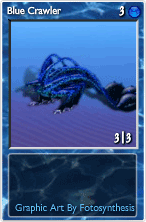 | Blue/Abyss Crawler
Just a strange-looking blue creature which makes iancu's heart melt. Cheap and effective creature for bows. Not sure if there is a real life equivalent for these creatures. Starfishes, octopuses, stingrays, sea cucumbers, crabs, sea turtles, some sponges, worms, sea snails, shellfishes, young barnacles do crawl. This one is a deep see crawler (abyss), but reminisces none of them. Seems Zanz wanted to show that deep see creatures might look strange and can possess odd properties (6|6 is quite good for such a simple creature).
Spoiler for Blue: Some thoughts about the color blue. Linguist were surprised that they haven't found a word for 'blue' in ancient Greek texts. Moreover there is no distinct word for blue in Chinese, Sanskrit or Hebrew. Blue was often associated with other, similar colours like green. Egyptians had a word for blue, because they knew blue pigments. My resource didn't mention it, but my guess would be azurite - they used a lot of different powdered minerals (even toxic ones) for make-up purposes. My other guess is indigo, that's a proper blue dye. (Normally they must have known both. I left my musings here instead of editing out, but later I found that Egyptian blue was another mineral: calcium copper silicate.) Amusingly enough linguist also had the idea that the Greeks might have been colorblind. They had three arguments. First, Greeks often communicated colors as light (glaukos - yellow, grey, light green etc.) and dark hues (kyaenos - violet, black, dark blue etc.). Other argument arose when an Aboriginal tribe was discovered who considered the sky rather black than blue. And lastly, Homer used some strange description about certain things in his work, like calling honey 'green', and sheep 'violet'. Maybe Homer was colorblind?  Or he just liked to use funky attributes? Nevertheless humans have color vision, and all ancestors had it in the last few million years. Let's step back to that ancient pigment, indigo. Many, many cultures* have known this dye, since it was obtained from a common plant, Indigofera tinctoria (true indigo). In fact, the oldest known fabric dyed indigo dated to 6000 years ago, and was discovered in Peru. Greeks also knew this dye. There is something wrong with those linguist arguments, explanations. The sky is blue, the oceans are blue, there are blue eyes and there is this omnipresent beautifully dark blue dye. No way they couldn't perceive blue as a color. The real explanation is more interesting. An experiment with the Himba people (native to Namibia in southwest Africa) helped to solve the conundrum. The Himba people are able to maintain their tradition to live a life entirely cut off from Western influence. They have only five words for colors. They would use the same words for shades for which we have a spectrum of different words. At the same time, being the children of Mother Nature they can differentiate a lot of different green shades, and they treat them as entirely different colors. Scientists showed them two color wheels. One of them featured only light green squares - but one of these squares had a very slightly different hue. They easily picked it out. The other picture also featured light green squares, but with an extra light blue square. They had a difficulty naming the light blue one. But when they were asked to handpick the different square, they easily did it. This shows that they were able to see the color blue, they just didn't meet with it daily, it haven't got incorporated into their language. Languages are formed by experiences. If a group of people sees a light reddish hue often, sooner or later they might create a different word for it: pink. Ancient people saw blue. They might have categorized colors a bit differently, but nevertheless they were able to detect them - we are talking about million years of evolution, that won't disappear magically for certain selected centuries. Spoiler for *: Peru, India, China, Japan, Mesopotamia, Egypt, Britain, Mesoamerica, Iran, West Africa, Greece, Rome.
|  |
| | |
 | Freeze/Congeal
Ever wondered why do we use 'melting points' instead of 'freezing points'? Of course, the term freezing point is used as well, but rarely and only in specific situations. (Like freezing point depression, but that's a bit different topic.) First we must compare melting and freezing. Solid materials have their crystal building particles fixed in place where they can only oscillate (vibrate). Imagine them like little balls connected by springs (metaphor for the bonds between them). The springs hold them in place, though they have some sort of flexibility (the aformentioned oscillation/vibration). Higher temperature means stronger vibration. If the vibrations get strong enough it can break the springs (bonds between the particles). At this moment the solid material melts, and the current temperature is its melting point. Stronger bonds mean a higher melting point. For example nitrogen has a melting point of -210 Celsius degree, while water melts at 0 Celsius degree, and wolfram melts only at 3422 Celsius degree. So what's the difference with freezing? It must be the same - just backwards - right? Well, nope. When we have a liquid and we cool it down it won't necessarily freeze at the melting point. Crystal formation is a tricky process. Logically we would expect that as particles get closer and closer, because of the weaker vibrations, bonds start forming, and voila: freezing. Thing is that first a nucleation must happen: there have to be a starting point where the crystal can start growing. If the liquid already contains a piece of solid of the same material then it'll happen quickly. If not, we must wait, until the particles collide in the correct orientation and a nucleus forms (the "starting" crystal). From another perspective: there is an energy barrier when we move from liquid state to solid state and because of that energy barrier the crystallization happens often below the melting point. The phenomenon is called supercooling. For example water can be supercooled to -40 Celsius degree before freezing. (It is an experiment which you can try at home. Won't be successful all the time, but sometimes when you put a plastic bottle full of water into the fridge it won't freeze, but when you remove it, disturb it a bit, it freezes instantly.)
So, that's why we use 'melting points', because freezing points are unreliable. Luckily 'freeze' is a reliable enough spell in this game. Though sometimes it is questionable that you can freeze some fiery creatures, plus icy creatures oddly enough doesn't have any freeze immunity. Guess the reason is balance, or it would have been just too difficult to implement something like this (it would have been cool if stony creatures would have got some damage after freezing due to erosion). Congeal is again the "oh my, what synonym should I use for the upped card?"-sillyness. The first meaning of congeal is pretty much the same as freezing. The second meaning works for colloids as well, for example when blood curdles it can be called congeal as well (coagulation). All in all any sort of solidification or thickening can be called congealing. From this perspective it is a strange choice for the upgraded counterpart.
|  |
| | |
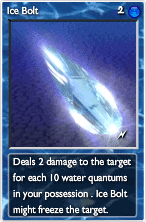 | Ice Bolt/Lance
Fire Bolt ice version. It is a very nice touch that they are able to freeze weapons with a certain percentage. (Random Submachine popping up in my mind and starts smiling and saying: "Hey Wyand, do you remember that tournament when my lances froze your weapon in every try?"  ) Also less damage because of it. ) Also less damage because of it.
|  |
| | |
 | Ice/Permafrost Shield
A thermodynamically supported permanent.  If you touch something cold it'll draw heat from your body. (See? Heat travels from the hotter place towards the colder place.) It is nice how it got implemented to the game. Ofc an instafreeze shield would have been op, so logically it got its own rng as well. Still a very strong - often underestimated (maybe due to its cost) shield. Permafrost is an upgrade name I like, because it draws your attention to something important (if you have the curiosity - and I do hope you have, playing such a science-based game). Permafrost. 'Always frozen'. By definition, always is about at least 2 consecutive years. The ground must remain continuously under 0 Celsius degree, and it must be on land or under the ocean. Interestingly enough it doesn't have to be the first layer on the ground which is frozen. It can be even several miles deep under the surface. Usually permafrost contains a lot of biomass. Why is it interesting? Because permafrost areas are getting warmer and warmer, and ultimately the overall permafrost areas will shrink. OK, so what - someone might say. Look back a line: it contains a lot of biomass... mainly in the form of methane... Methane is a strong greenhouse gas. And it can create a vicious feedback cycle: hotter days, more methane gets released, even more hotter days... goto more methane... and so on... If you touch something cold it'll draw heat from your body. (See? Heat travels from the hotter place towards the colder place.) It is nice how it got implemented to the game. Ofc an instafreeze shield would have been op, so logically it got its own rng as well. Still a very strong - often underestimated (maybe due to its cost) shield. Permafrost is an upgrade name I like, because it draws your attention to something important (if you have the curiosity - and I do hope you have, playing such a science-based game). Permafrost. 'Always frozen'. By definition, always is about at least 2 consecutive years. The ground must remain continuously under 0 Celsius degree, and it must be on land or under the ocean. Interestingly enough it doesn't have to be the first layer on the ground which is frozen. It can be even several miles deep under the surface. Usually permafrost contains a lot of biomass. Why is it interesting? Because permafrost areas are getting warmer and warmer, and ultimately the overall permafrost areas will shrink. OK, so what - someone might say. Look back a line: it contains a lot of biomass... mainly in the form of methane... Methane is a strong greenhouse gas. And it can create a vicious feedback cycle: hotter days, more methane gets released, even more hotter days... goto more methane... and so on...
|  |
| | |
 | Purify
Oh, the purifying power of water! Such a beautiful and ancient symbol! Water is life. Without food your body might use your reserves and you get to live for weeks. Without water you'll die of thirst within days (about 3 or 4, depending on person and situation). When you go home after a tiring day, it feels so good to have a glass of cold water! You get a small cut: let's clean it with water first! Getting sick or poisoned: water is always good. Water is an elixir itself! People always wanted to create the elixir of life, those fools haven't seen that we already had it, and it is called water! Thanks Zanz for strengthening this beautiful metaphor!
|  |
| | |
 | Arctic Squid/Octopus
Two very similar molluscs, though they belong to different subgroups. They are both quite intelligent animals, especially among invertebrates. They can't really freeze targets, but they can grab them with their arms/tentacles - guess that's what brought Zanz to give them some sort of restrictive ability. Needless to say they are op, no wonder they have only 2 hp (though they are much bulkier than a froggy, right?). One thing that puzzles me that squids have 2 tentacles and 8 arms, while octopuses* have only 8 arms. Which is sort of a downgrade. Maybe the Giant Squid was the inspiration (the Colossal lives in Antartic regions), though the card graphic doesn't really resemble to it.
|  |
| | |
 | Trident/Poseidon
Poseidon had a trident. Now a Trident has an upped version: Poseidon. Greek god of the sea, storms, earthquakes. No wonder this op little thingy is able to sink your pillars, pends (sometimes even marks, as well). Water can cause some havoc on the land, too, so this is not just a good synergy, but a good metaphor as well. Btw, his trident was made by the Cyclopes. He used this trident to do some practical magic, like creating a spring with a single strike, or doing the opposite: drying out a land. (Not exactly earthquakes, but magical stuff happening to earth.) According to mythical texts the trident symbolizes 3 properties of water: liquidity, fecundity and drinkability. Another source claims it is three-pronged because "the sea is said to be a third part of the world, or because there are three kinds of water: seas, streams and rivers".
|  |
| | |
 | Ice/Arctic Dragon
Upgraded name extravaganza again: something living in the arctic zone is somehow better than simply just being a block of ice. True, ice isn't that hard (Mohs 1.5; you can scratch it with your finger). Considering other solid materials it is quite soft. Also a cold dragon like this should have an ice breath or something, but the freezer portfolio is already taken by those seawater molluscs mentioned earlier. (Somehow I feel Ice Dragons preceded squids, so I don't know why haven't they got such a random property - freezing creatures/weapon with a X% chance.)
|  |
| | |
 | Toadfish/Puffer Fish
There is much, much confusion here. In fact the card picture also looks like a crossover between a toadfish and a pufferfish. What I found that toadfish groups are often named pufferfishes and vice versa... There are different families, though. Batrachoididae are called toadfishes. Most of them are living on the ocean floor (not necessarily in deep ocean, it can be a shore line as well, the emphasis is on the 'floor'). Tetraodontidae family consists mostly of pufferfishes, though some of the species are called 'toadfish', too. And there is the Diodontidae family which are also called pufferfishes, though they are only related to the Tetraodontidae. And lastly there is the Psychrolutidae family, which also has a few species called toadfishes. Many of these fishes are brutally poisonous (they have a toxin named tetrodotoxin* which is 100 times more lethal than a black widow spider's venom). The toxin is produced by bacteria probably acquired by the fish by eating other animals infested with this bacteria. Through evolution the fishes got insensitivity for the poison. Their liver (skin, ovary and eyes too) contain this toxin. There is no known antidote for this poison. That's why you have to remove certain parts of these fishes when preparing a fugu... Pufferfishes are able to inflate themselves, this isn't common for toadfishes...
I don't know if Zanz got confused looking up these critters, or just wanted to show the confusion with the mixed look and properties. Gameplay-wise inflate is a nice skill, and it is also interesting how differently works the poisoning for the upgraded creature.
|  |
| | |
 | Mind Flayer/Ulitharid
Powerful D&D creatures (they are also named 'Illithids' there). They are able to dominate the mind of other creatures. Or we can say that they have psionic powers ( , see later), though in Elements they are "only" able to take away the skill of others instead of true mind control (let's call it mental castration, which is fundamentally different from mental subjugation, domination, abuse). They look somewhat like miniature skinny Cthulhus. , see later), though in Elements they are "only" able to take away the skill of others instead of true mind control (let's call it mental castration, which is fundamentally different from mental subjugation, domination, abuse). They look somewhat like miniature skinny Cthulhus.  The elite mind flayers are the ulitharid. The elite mind flayers are the ulitharid.
|  |
| | |
 | Nymph's Tears
In the Greek mythology Pirene was a nymph, a daughter of a river god. When her son (Cenchrias) was killed* her grief was so immense that she completely turned into tears then into a fountain that still bears her name in Corinth. In another story Atlas' son, Hyas was killed in a hunting accident, and his sisters, the Hyades wept from their grief. (Hyades means 'rain-maker'.) A cluster of stars, the Hyades are named after them, since the myth claims that they were turned into this group of stars located in the Taurus constellation.
Though, none of the stories mention something like tears turning pillars into beautiful magical women, they were probably a good basis for Zanz's fantasy. Nymph's Tear is also a component for crafting a magical ring in the computer game Baldur's Gate II: Throne of Bhaal**.
|  |
| | |
 | Flooding/Inundation
A small flood which only scares people a bit, can be even "fun". A proper flood isn't fun at all. A nice definition for it states that "A flood is an overflow of water (or rarely other fluids) that submerges land that is usually dry". Both flood and inundation cause the same effect, the difference is that an inundation isn't a sudden natural event, but a planned, man-made coverage of an area with water for agricultural, military or other reasons. If you want to keep up with these, you'll need lots of water ( ). ).
| 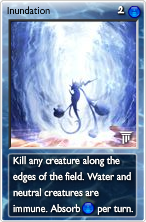 |
| | |
 | Steam Machine
Oh, boy, a little physics! And what a beautiful metaphor created by Zanz again! You have water (needs water quanta to deploy the creature), you boil it (needs fire quanta to make it happen), and voila, you have steam! Which is more powerful than you would have thought! Since the attack always grows when creating more steam, it would imply that it accumulates kinetic energy somehow. Because of this personally I would prefer if the machine would have some limitations, like more and more steam means constantly growing pressure and also damage to the equipment.
By definition it is a heat engine converting part of this heat energy into work using steam as its working fluid. The hot steam expands under pressure which pushes a piston back and forth in a cylinder. The remainder of the heat may be allowed to escape (This is what I mentioned before, this is the great difference from this card's operation.) The first documented steam engine was the Greek aeloipile in the 1st century. Most likely it didn't have any practical usages, it was just a curiosity. The first patented invention happened in the 17th century - it was used for pumping water in mines. But later on locomotives, cars and even ships were powered by steam. Steam turbines are still used nowadays. Nuclear power plants generate electricity by heating water (the heat is due to splitting atoms) to provide steam that drives a turbine connected to an electric generator.
| 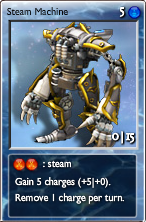 |
| | |
 | Dry Spell/Desiccation
The first is a long period of dry weather. Not as serious and long as a drought, but still pretty bad. Desiccation is the process of extreme drying. Like when you have some leftover pasta on your plate and you 'forget' to do the dishes for a week. Or 2. (To me it sounds like Abi-Dalzim's Horrid Wilting /AD&D spell/.) Since most living tissue, and a lot of food items are gels, these gels' water percentage can change over time. In this context desiccated gels are considered as xerogels (gels with very low or zero water content). Gels contain a colloid/polymer network which remains after desiccation. Simply put it is a remove water spell, which would fit more rationally to  or or  , costing , costing  or or  quanta and generating quanta and generating  . Understandable that balance reasons made Zanz to put it between . Understandable that balance reasons made Zanz to put it between  cards. cards.
|  |
| | |
 | Nymph Queen
Since this is a  card, we can safely say that nereids (sea nymphs) and naiads (different types of freshwater nymphs) are the closest link in the Greek mythology. Looking at hierarchies, we find that Amphitrite is the eldest of the Nereids, also the wife of Poseidon. She is also the goddess and queen of the seas. To complicate matters there is also Thalassa, who is the primordial goddess of the sea. In a way Thalassa is the goddess, while Amphitrite is her antropomorphic version, the ruler of the elemental Thalassa. (The same is true for the male counterpart, Poseidon/Pontos.) card, we can safely say that nereids (sea nymphs) and naiads (different types of freshwater nymphs) are the closest link in the Greek mythology. Looking at hierarchies, we find that Amphitrite is the eldest of the Nereids, also the wife of Poseidon. She is also the goddess and queen of the seas. To complicate matters there is also Thalassa, who is the primordial goddess of the sea. In a way Thalassa is the goddess, while Amphitrite is her antropomorphic version, the ruler of the elemental Thalassa. (The same is true for the male counterpart, Poseidon/Pontos.)
| 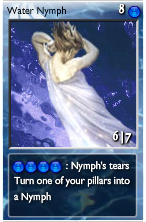 |
| | |
 | Shard of Patience
Nothing here. You just need a little patience* to get some overpowered creatures. No idea why it ended up here, no connection to water whatsoever. Maybe Zanz thought that water cards aren't beefy enough. The +5|5 for  creatures might be explained how Zanz must have realizes that instead of helping only water with this card, he helped all other elements as well. The only patience you need is to wait until you get your copy for instawin from your deck.** But I'm getting circular. creatures might be explained how Zanz must have realizes that instead of helping only water with this card, he helped all other elements as well. The only patience you need is to wait until you get your copy for instawin from your deck.** But I'm getting circular.
|  |
| | |

